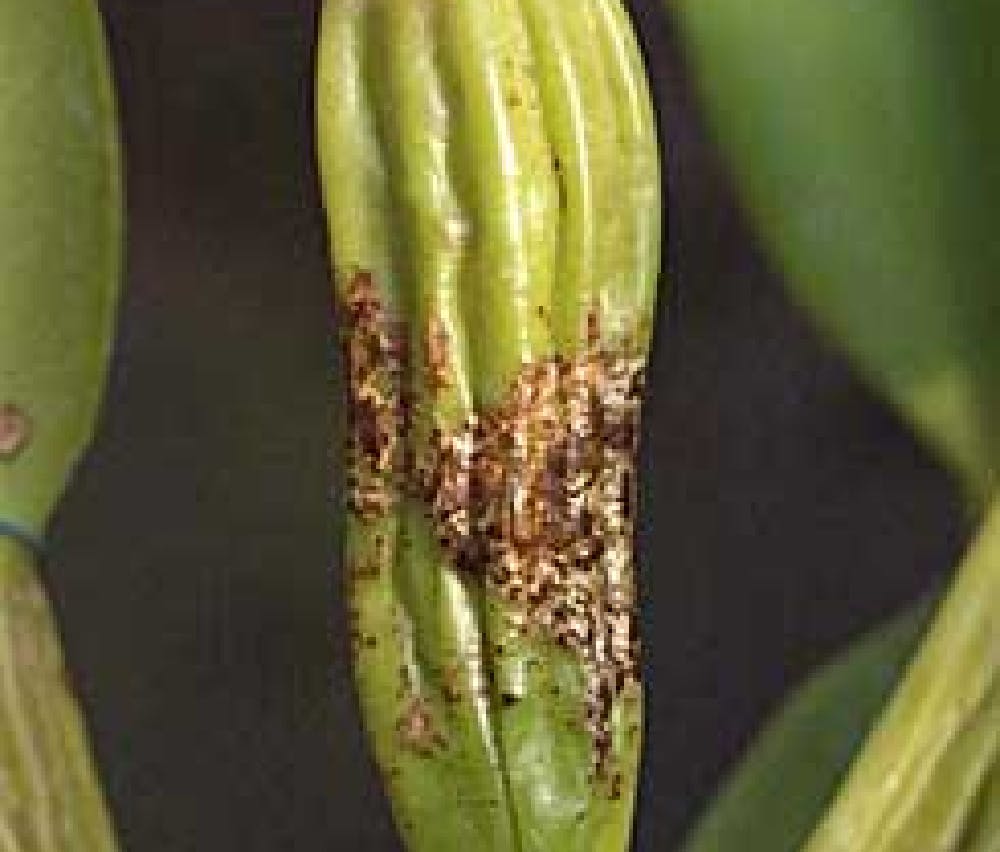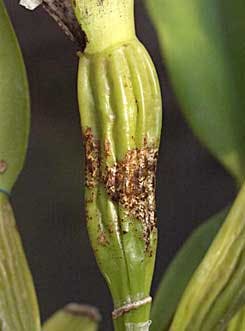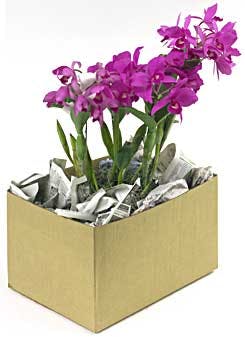
Handling Damage


Gallery


Prevention
In addition to simply careful handling of plants during movement and repotting, wearing disposable gloves helps to minimize fingernail scratches to soft new growth and roots when repotting and will help to prevent accidental transmission of any diseases that might be present in your plants.
Additional Information
By Susan Jones
In addition to the loss of the investment of time, patience, energy and care in the orchid’s growth, the point of injury to the remaining plant tissue has become a weak spot through which virus, fungi and bacteria can enter and further damage the orchid.
The harm that occurs during these accidents is permanent; a healthy plant will heal around it, but the affected tissue will remain scarred from its accident. Eventually the impacted area may be removed during repotting and division once sufficient new growth has occurred. In the meantime, the plant will bear the marks of its mishap, which can reduce not only its aesthetic appeal, but its scoring potential – mechanical damage can negatively impact the judges’ scoring of the plant or even preclude it from award consideration altogether at AOS judging.
Further Reading
Bribie Island Orchid Society. “Plant Information: Pests and Diseases"
Susan Jones was the editor of Awards Quarterly and assistant editor of Orchids. American Orchid Society, 16700 AOS Lane, Delray Beach, Florida 33446
All reuse must contain the follwing:
Reprinted from the SEPTEMBER 2003 issue of Orchids -- The Bulletin of the American Orchid Society. Copyright American Orchid Society -- www.aos.org
Accidents
Most growers have at some point dropped or knocked over a prized plant, marring its formerly perfect foliage, or snapping off that long-awaited inflorescence or new growth.
Orchid growers are an acquisitive lot, and collecting orchids has often been compared to eating potato chips — the similarity being that in either case it is difficult to stop at just a few. A basic but often-overlooked aspect of successful cultivation of any orchid collection is a healthy growing area that allows the grower free movement through the plants and ease of watering, fertilizing and pest control. Do not allow plants to become crowded in the growing area — a cluttered growing space is asking for trouble. Not only does overcrowding provide fertile grounds for the spread of pests and diseases, but it also increases the likelihood that plants will be knocked over or on top of one another, suffering and sometimes inflicting injuries.
Removing Tissue
If a plant part has become damaged or diseased, sometimes the affected portion must be removed in order to save the rest of the orchid. Common examples of this would include a raggedly torn leaf or an area infected by fungus or bacteria. The compromised tissues must be cut away, and with them a portion of the healthy plant material in order to stop the spread of the rot. This should always be done with a hot, sterile cutting tool in order to cauterize the healthy tissue as the cut is made. The fresh cut should then be covered with a fungicide paste (see Treating Wounds). A weekly fungicide spray during the recovery period helps ensure no opportunistic infections reoccur.
Transporting Plants
Pack plants carefully when transporting them home from a nursery or show, to and from judging and orchid society meetings. Plants are better protected in boxes or cartons than loose in the car. Even a newspaper or piece of wrapping paper rolled into a sleeve around the plant and taped closed will help keep it safer during transportation. Take the extra time to carefully situate and protect bloom spikes and flowers against bending and breakage in transit before transporting your plants.
When orchid shopping, bring along an extra stash of boxes or bags, plus some lightweight packing materials unlikely to damage your new acquisitions such as polyester batting, finely shredded paper or foam packing peanuts. Most, but not all, sellers will supply some sort of protective materials to keep the plants they sell safe during the trip to their new home, but for those times when a seller is unprepared, has run out, or is simply too busy to wrap your purchases, it helps to have one’s own materials on hand.
Repotting and Dividing
When repotting, dividing, staking and removing dead sheaths and leaves from plants, use extra caution and go slowly. Make sure there is enough room on the potting bench to work comfortably, and all tools, pots, stakes, clips and other materials are sterilized before coming into contact with each plant. Some growers recommend sterilizing cutting tools between every cut, even on the same plant. Unsterile or improperly sterilized tools and materials are an excellent vector for spreading virus between plants.
After unpotting the orchid and removing old media from the roots, dust the roots with fungicide before repotting. When using a commercially prepared fungicide, be sure it is labeled as safe for orchids and follow all dosage recommendations and safety precautions. Sulfur powder also functions as a fungicide and an insecticide. A more environmentally friendly alternative is powdered cinnamon, which has fungicidal properties, but is much safer for use in the home around people and pets.
Wounds
A cut in human skin needs to be guarded against infection — likewise, a break in the tissue of an orchid is vulnerable to invasion by virus, bacteria and fungus. Apply a fungicide such as Bordeaux mixture to the open surface of cut plant tissue, such as a divided rhizome or a broken or trimmed leaf. Bordeaux serves as both a fungicide and an insecticide, and is made by mixing copper sulfate, hydrated lime and water. It is available premixed dry or as a paste, or can be made up as a spray by dissolving 2 parts copper sulfate and 3 parts hydrated lime into 26 parts water. Less water will make a paste that can be spread over open cuts in orchid tissue. Bordeaux is most effective when applied while fresh and kept well mixed during use.

FREE ACCESS: Orchid DealWire
Get notified when orchid vendors have special promotions and exclusive savings.



